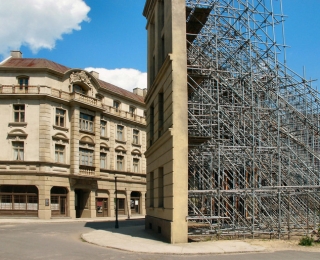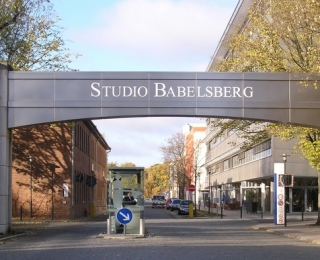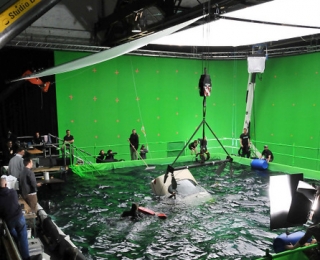Studio Babelsberg is the oldest large-scale studio complex in the world and one of Europe’s leading service providers for feature films and TV productions. Since 1912, countless renowned filmmakers have worked with Studio Babelsberg to produce legendary films. With a complete set of services that make Studio Babelsberg a one-stop shop, the studio employs one of the best crews in the world and is well known for its unique production service, skillful set construction department and huge prop shops.
Many of Germany’s most famous classic films have been created at the stages and facilities of Studio Babelsberg, including Fritz Lang’s Metropolis and Josef von Sternberg’s The Blue Angel, starring Marlene Dietrich. More recent movies shot here include Quentin Tarantino’s Inglourious Basterds, Roman Polanski’s The Ghost Writer and Roland Emmerich’s Anonymous.
With 16 sound stages, various back lots and exterior sets on a 39-acre lot, fist-class technical capabilities, highly skilled crews, attractive shooting locations nearby and its close proximity to the trendy city of Berlin, the Studio offers ideal conditions for any production need. In addition, Studio Babelsberg offers a wide variety of co-production and financing services and opportunities.
At the moment, the studio does not offer tours, but the nearby FilmPark Babelsberg is worth a visit.
Productions shot at Babelsberg Film Studios
Feature Film (54) | |||
| Title | Released | Director | IMDB |
|---|---|---|---|
| Bridge of Spies | 2015 | Steven Spielberg |  |
| The Grand Budapest Hotel | 2014 | Wes Anderson |  |
| Hansel & Gretel: Witch Hunters | 2013 | Tommy Wirkola |  |
| The Book Thief | 2013 | Brian Percival |  |
| The movie was shot in Germany, with the main location Himmel Street being built on the backlot at Babelsberg Studios over a 10 week period. Most of the street was built from scratch, with one building being used that was already on the backlot. Babelsberg stages were used for interiors and for costume fittings for the 450 extras using throughout the movie. | |||
| Cloud Atlas | 2012 | Lana Wachowski, Tom Tykwer, Andy Wachowski |  |
| Anonymous | 2011 | Roland Emmerich |  |
| The first major full-length motion picture to be shot with the Arri ALEXA high-definition digital-video camera. | |||
| Apparition, The / The Apparition | 2011 | Todd Lincoln |  |
| Chicken with Plums | 2011 | Vincent Paronnaud, Marjane Satrapi |  |
| Hanna | 2011 | Joe Wright |  |
| The Three Musketeers (3D) | 2011 | Paul W.S. Anderson |  |
| Unknown | 2011 | Jaume Collet-Serra |  |
| The Ghost (aka The Ghost Writer) | 2010 | Roman Polanski |  |
| Inglourious Basterds | 2009 | Quentin Tarantino |  |
| International, The | 2009 | Tom Tykwer |  |
| Lilly the Witch: The Dragon and the Magic Book | 2009 | Stefan Ruzowitzky |  |
| Mr. Nobody | 2009 | Jaco Van Dormael |  |
| Ninja Assassin | 2009 | James McTeigue |  |
| Pandorum | 2009 | Christian Alvart |  |
| Flame & Citron | 2008 | Ole Christian Madsen |  |
| Reader, The | 2008 | Stephen Daldry |  |
| Speed Racer | 2008 | Andy Wachowski, Lana Wachowski |  |
| Valkyrie | 2008 | Bryan Singer |  |
| The Bourne Ultimatum | 2007 | Paul Greengrass |  |
| Black Book | 2006 | Paul Verhoeven |  |
| Constant Gardener, The | 2005 | Fernando Meirelles |  |
| Flightplan | 2005 | Robert Schwentke |  |
| V for Vendetta | 2005 | James McTeigue |  |
| Around the World in 80 Days | 2004 | Frank Coraci |  |
| The Bourne Supremacy | 2004 | Paul Greengrass |  |
| Pianist, The | 2002 | Roman Polanski |  |
| Enemy at the Gates | 2001 | Jean-Jacques Annaud |  |
| Gangster No. 1 | 2000 | Paul McGuigan |  |
| Sonnenallee | 1999 | Leander Hau�mann |  |
| Held for Questioning (Der Aufenthalt) | 1983 | Frank Beyer |  |
| Solo Sunny | 1980 | Konrad Wolf, Wolfgang Kohlhaase |  |
| Sieben Sommersprossen | 1978 | Herrmann Zschoche |  |
| Jacob the Liar (Jakob der Lügner) | 1975 | Frank Beyer |  |
| Naked Man in the Stadium, The (Der nackte Mann auf dem Sportplatz) | 1974 | Konrad Wolf |  |
| Legend of Paul and Paula, The (Die Legende von Paul und Paula) | 1973 | Heiner Carow |  |
| Goya � oder der arge Weg der Erkenntnis | 1971 | Konrad Wolf |  |
| Ich war neunzehn | 1968 | Konrad Wolf |  |
| The Trace of Stones (Spur der Steine) | 1966 | Frank Beyer |  |
| Die Abenteuer des Werner Holt / Adventures of Werner Holt | 1965 | Joachim Kunert |  |
| Der geteilte Himmel | 1964 | Konrad Wolf |  |
| Karbid und Sauerampfer / Carbide and Sorrel | 1963 | Frank Beyer |  |
| Naked Among Wolves (Nackt unter Wölfen) | 1963 | Frank Beyer |  |
| Sterne | 1959 | Konrad Wolf |  |
| Sun Seekers (Sonnensucher) | 1958 / 1972 | Konrad Wolf |  |
| Story of Little Mook, The | 1953 | Wolfgang Staudte |  |
| Das Beil von Wandsbek | 1951 | Falk Harnack |  |
| La Habanera | 1936 | Douglas Sirk |  |
| The Blue Angel | 1930 | Josef von Sternberg |  |
| Metropolis | 1927 | Fritz Lang |  |
| The Cabinet of Dr Caligari | 1920 | Robert Wiene |  |
Short Film (1) | |||
| Title | Released | Director | IMDB |
| The Dance to Death | 1912 | Urban Gad |  |
Facilities
- 16 sound stages [See Studio_Babelsberg_Studio_Flyer for more details]
- Various back lots and exterior sets on a 39-acre lot
- Stage 1: Marlene Dietrich Halle
With its total floor space of 60,000sqft and its 46ft. ceiling, this stage counts among Europe’s largest sound stages – an ideal location for feature film production. The complex is divided into three stages, the main 22,600sqft. stage and two additional stages, offering 17,760sqft. each. The stages at Marlene Dietrich Halle are all equipped with a broadband communication network (Monomode). - Stage 2: Tonkreuz
This historic building was erected in 1929 as Germany’s first sound stage. It now houses a high-tech film and television production complex, outfitted with the latest technology. - Stage 15
78,954 sq ft.
Backlot
Berliner Street
In the fall of 1998, Studio Babelsberg built a permanent exterior film set modeled after a typical Berlin street setting. The set is built on a 1.7acre lot and includes 26 facades.
The feature films Sonnenallee, The Pianist and Flame & Citron have been all shot on the back lot.
The facades resemble a typical urban architecture of the late 19th, early 20th century and can be easily dressed to incorporate European cities such as Paris, Rome or London.
Village of the Middle Ages
This set was built for a movie in 1984, and is now part of the Filmpark studio tour.
History
1911 – Bioscop company builds it’s first film studio in Babelsberg. The stages are constructed completely of glass to allow maximum sunlight onto the stage.
1912, February 12th – Filming begins for The Dance of the Dead by Danish director Urban Gad.
1918 – After the World War I, the Deutsche Bioscop Gesellschaft merges with the German branch of the French film concern Eclair Decla in Babelsberg into “Decla Bioscop”.
1921 – Decla Bioscop becomes part of Universum Film AG (UFA) which had been founded in 1917.
1926 – UFA builds the large studio (which is now known as the “Marlene Dietrich Halle” and still in use today) to accommodate the huge sets for the major film production of Metropolis by Fritz Lang.
1929 – The first German sound stage in Babelsberg, the Tonkreuz, is built. Melodie des Herzens/Melody of the Heart with Willy Fritsch was the first German full-sound film.
1930 – The premiere of The Blue Angel by Josef von Sternberg starring Marlene Dietrich and Emil Jannings.
From 1933 to 1945, around 1,000 feature films were made in the studios and on the studio lot. Under the direction of Hitler’s propaganda chief Joseph Goebbels, the studio churned out hundreds of films including Leni Riefenstahl’s openly propagandistic Triumph of the Will. The virally anti-Semitic propaganda film Jud Süss (The Jew Süss), shot in 1940, was also made at Babelsberg.
1946 – May 17 – The DEFA – Deutsche Film AG – was established. It produced over 800 feature films, including 150 children’s films. In addition, over 600 films were produced for television from 1959 to 1990. The DEFA period was honored by the Museum of Modern Art (MOMA) in New York in 2005.
After the fall of the Berlin Wall, the Treuhand took over the responsibility for the privatisation of the former DEFA. In August 1992, the Treuhandanstalt sold the former DEFA film studios in Babelsberg to the French group Compagnie Générale des Eaux (later absorbed into Vivendi Universal). Over the following 12 years the company invested around €500 million updating the studio’s infrastructure.
1998 – Fall – A permanent exterior film set is built, modeled after a typical Berlin street setting. The set is built on a 1.7acre lot and includes 26 facades. The feature films “Sonnenallee”, “The Pianist” and “Flame & Citron” have been all shot on the back lot. The facades resemble a typical urban architecture of the late 19th, early 20th century and can be easily dressed to incorporate European cities such as Paris, Rome or London.
In July 2004, Vivendi sold Studio Babelsberg to the investment company FBB (Filmbetriebe Berlin Brandenburg GmbH), which has Carl Woebcken and Christoph Fisser as shareholders. In Spring of 2005, the restructured studio presented an initial public offering and began trading on the free market.
2007 – The most profitable year since the Studio’s privatization in 1992 – 12 feature films were shot at Studio Babelsberg, among them Valkyrie with Tom Cruise, The International with Clive Owen, and The Reader with Kate Winslet.
In 2008 Studio Babelsberg and Hollywood producer Joel Silver formed a strategic alliance to produce feature films from the Dark Castle production slate at the world’s oldest film studio.
Recent co-productions of Studio Babelsberg include Quentin Tarantino’s Inglourious Basterds and Roman Polanski’s The Ghost Writer.
2010 – Studio Babelsberg announces a joint venture with Paris based production and sales outfit Celluloid Dreams and Munich based financing company Clou Partners.
2012 – Studio Babelsberg celebrated it’s 100th anniversary.



